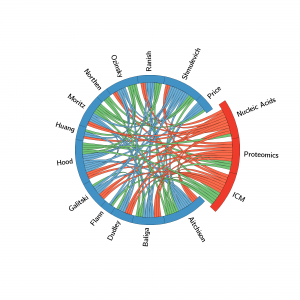It Takes A System To Know A System
 isbscience.org/news/2012/11/23/it-takes-a-systems-to-know-a-system/
isbscience.org/news/2012/11/23/it-takes-a-systems-to-know-a-system/

Figure depicting cross-disciplinary collaborations among lab groups and usage of technologies housed in ISB’s core facilities.
In August, ISB learned that our National Center for Systems Biology was renewed for $13.7 million over the next five years. This is no small feat given that only two National Centers were funded in this round and that there’s fierce competition for diminishing government grants. Here’s how your tax dollars are being put to use:
First, some background. The U.S. Department of Health & Human Services (HHS) is the U.S. government’s main agency for protecting the health of all Americans. It administers more grant funds than all other government agencies combined. HHS manages Medicare and Medicaid among many programs, and agencies such as the Food and Drug Administration (FDA), the Centers for Disease Control and Protection (CDC), and the National Institutes of Health (NIH).
The NIH consists of 27 institutes and centers, one of which is the National Institute of General Medical Sciences (NIGMS). The NIGMS is responsible for funding research that advances diagnosis, treatment and prevention of diseases. Systems biology is one area of focus. Currently, the NIGMS funds 15 National Centers for Systems Biology, one of which resides at ISB. ISB’s Center for System Biology was awarded in 2006 and the funding renewal signifies NIGMS’s continued trust in our ability to fulfill the scientific, technology, and education aims set forth in our proposal.
At the core of systems biology is the belief that diseases arise from “broken” networks, which is to say that diseases result from a collection of causes that make it necessary to study the whole system in order to locate where, when and how normal cellular interactions go awry. Because an individual’s genetics and the environment contribute to the formation of these abnormal networks, the heterogeneity – or individuality – of any given disease is complex and staggering.
What’s necessary to study the whole system are teams of cross-disciplinary scientists whose complementary skills and perspectives can ferret out the culprits behind humankind’s most devastating diseases. Basically, it takes a system to know a system. But why do we need a Center when we are already an Institute and what is its purpose?
The National Centers propagate systems approaches and applications to the greater scientific community through science, technology and education programs. ISB pioneered systems biology and with our 12-year history of applying systems approaches to research and education, the NIGMS recognized that our National Center remains poised to impact the greater community. As we publish our research, share our technology and train future systems biologists, your tax dollars reach beyond our walls to K-12 schools, college and graduate programs, and the wider research and healthcare communities. The Center’s purpose, or how ISB will apply the $13.7 million, is based on a deceptively simple question:
HOW DO HEALTHY SYSTEMS BECOME DISEASED SYSTEMS?
ISB’s Center, which is headed by Dr. John Aitchison, ISB’s Executive Director for Integrative Biology, states three main aims in its proposal:
Decipher complexity and innovate: Develop new systems-level approaches, tools and applications to understand biological complexity from the perspective of hierarchies of molecular and cellular networks that relay information and give rise to emergent behavior. Invent and share tools: Develop measurement and imaging core facilities that serve as venues for collaborative technology development, implementation and application in a variety of biological systems. Teach and nurture scientists: Develop and maintain education and outreach programs and an institutional culture of collaboration and training that fosters the development of systems biologists at multiple career levels.
These aims will drive three research projects that span ISB’s 10 faculty groups as well as several groups of external collaborators. The scope of the projects would take 50 single-spaced pages to outline, so here are some key systems biology principles behind the research.
Integration of multi-scale information: Molecular data is different from cellular data is different from tissue data and so on. In order to understand the whole system, scientists need to be able to assemble disparate data and trace the physical expression of those networks to paint a complete picture.
Model organisms: Our scientists use yeast and halobacterium, which are model organisms because they have the same cellular organelles and processes as human cells. Learning from model organisms then allows scientists to predict the behavior of human cells.
Single-cell analysis: Each cell is different and there is no average cell. It’s necessary to understand the individual differences in order to understand how a group or groups of cells interact together.
Core facilities: Systems biology requires and drives technology that can produce a large amount data, and the mathematical tools to analyze or attempt to make sense of the data. ISB democratizes resources and technologies to facilitate cross-disciplinary and inter-lab collaboration.
Knowledge transfer: Sharing knowledge, skills and technology grows and perpetuates the scientific community. It’s about investing in the greater good and the future.
Game-changing, revolutionary, paradigm-shifting research can occur only with the right combination of infrastructure and ethos that blends innovation, entrepreneurship, collaboration, creativity, and a grand vision.
And that’s who we are at ISB.




